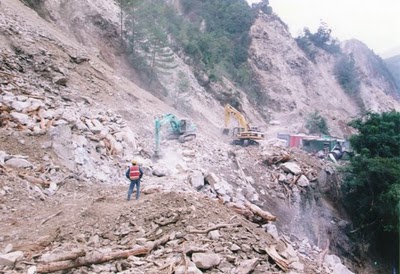29 May 2008
NASA imagery of Sichuan landslides
Posted by Dave Petley
NASA has now released a pair of ASTER images of the earthquake affected area. I should add that it is good to see some imagery of areas beyond Beichuan. These images really do highlight the magnitude of the landslide problem.
These images are centred on the Min Jiang river, which is about 150 kilometers from the epicentre of the earthquake. For a non-specialist they look a little odd – technically they are “false colour composites”, designed to allow classification of land use. Thus, the bright red colour represents areas of vegetation; blue-grey represents earth, stone or brick surfaces – which can mean bare ground, buildings and paved areas; and dark blue represents water. In the interpretation of landslides from a set of before and after images like this we typically look first for vegetated areas (i.e. red colours) in the first image that have become bare ground (i.e. blue-grey) in the second. We then look for the shape and location of the change, because deforestation or construction can also cause forested areas to become bare ground, stone or soil. Most landslides have an arcuate (i.e. curved) back-scar (this is the top of the landslide) for example, and earthquake triggered landslides in mountainous areas often start at the ridge or a break of slope and extend to the river. They are typically (but not exclusively) long and narrow. Land use change for deforestation or construction usually occurs in distinct blocks or along roads.
 NASA images collected by the ASTER satellite showing an area around the Min Jiang River in Sichuan. The bottom image was collected on 19th February 2003, the top one on 23rd May 2008. Click on the image for a better view.
NASA images collected by the ASTER satellite showing an area around the Min Jiang River in Sichuan. The bottom image was collected on 19th February 2003, the top one on 23rd May 2008. Click on the image for a better view.Now, as NASA point out, we do need to be a little careful in the interpretation of the images. This is an area that has undergone substantial change in recent years due to economic development and population growth, so some of what we see here might not have come from the earthquake.
What is clear is that there is extraordinary change between the images. Most of this change takes the form of a huge number of long, narrow strips that extend down the slope to the river. In these strips the land use has changed from vegetation (red) to bare ground (blue-grey). In places there are larger features with arcuate back scars.
My interpretation is that most of this change represents shallow (Tachia River area of Taiwan after the 1999 Chi-Chi earthquake. To provide an idea of what this looked like on the ground, this image was taken of this area about two weeks after the earthquake:
In this area the landslides themselves took a dreadful toll. Nearly ten years on the area is still struggling to get back on its feet as the landslides reactivate in every heavy storm. The debris reseased by the landslides has choked the rivers.



 Dave Petley is the Vice-Chancellor of the University of Hull in the United Kingdom. His blog provides commentary and analysis of landslide events occurring worldwide, including the landslides themselves, latest research, and conferences and meetings.
Dave Petley is the Vice-Chancellor of the University of Hull in the United Kingdom. His blog provides commentary and analysis of landslide events occurring worldwide, including the landslides themselves, latest research, and conferences and meetings.
Dear Dave:yes, the consequence damage of Da-Jia river after Chi-Chi earthquake is last untill to now. The serious debris flows was Typhoon Toraji 2000, Typhoon Midule 2003, Typhoon Ellie 2004, Typhoon Haitang 2005 and Typhoon Lungwang 2005. The serious year was 2004 with two hevay rainy type typhhons within 30 days. The rain of Typhoo Mindulle was last for 9 days with highest intensity up to 120 mm/hr. The precipitation intensity of Typhhon Elle also up to 90 mm/hr and last for 2 days. The consequence damage actually was serious than earthquake itself.I hope that the climate condition in future will not be so bad at Shichung as in Taiwan.
Dear Kung,Indeed, Prof. Hongey Chen and I published a paper on the in Quarterly Journal of Engineering Geology and Hydrogeology a couple of years ago. The damage to the Central Cross Island Highway, wjich runs through that area, is extreme and is essentially impossible to mitigate economically until the process rates slow. Unfortunately, Sichuan also gets very extreme rainfall events, and to my mind the level of landsliding is at least as bad.